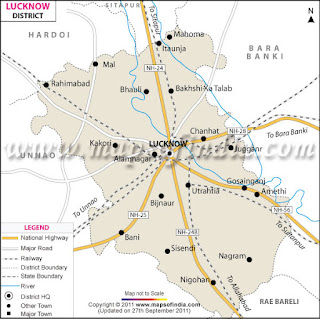 |
| in ruins Alambagh palace, Lucknow, UP lucknow.me |
 |
| Alambagh gate, Lucknow, UP |
Though renovation was done a few years ago both structures are in deplorable condition. Reasons: Persistent official apathy and encroachment of all kinds of shops near by. In 1947 this place was settled with refugees driven from Pakistan. In 2017 the Mangal bazaar near the Alambah gate and various shops were removed by the city authorities to make way for the up-coming metro project in this city. There should not be any building or construction activities within the radius of 300 meter from the site of monument acceding to monument guidance rules. Across India encroachers don't care a fig; they do it unmindful of warning board put up in many places. Reason: No stringent regulations and lethargic enforcement of laws. If the officials impose hefty fine and imprisonment, it will act as deterrent.
 |
| Alambagh palace, Lucknow, UP lucknowobserver.com |
 |
| Lucknow location map Maps India.com |
Despite passage of time both the brick-red colored two-story palace and the made of lakhauri bricks have not the charm. the palace has spacious hall with large rooms, interior walls decorated with floral designs and tall rooftop. Now the decorations and the floral designs are in bad shape. Nawab Wajid Ali Shah who went into exile during the worst revolt used both Mogul and European style of design for the palace.
This area of Lucknow (once the capital of Awadh kingdom) was once a scene of intense freedom struggle and rampage during the 1857 war of Independence that started off at Meerut cantonment. The Indian fighters used some of the buildings as military post to wage war against the oppressive British till September 1857. The EIC's army led by Gen. Havelock finally took control of the palace and other places and converted in to military hospital to treat the injured and sick soldiers. The English general died in this place on 23 November and on the following a\day he was buried here. A tomb in the memory of General Havelock was also constructed here by his relatives.
The sad commentary is some impressive buildings that were not part of this are were also damaged during the revolt. It was not by the Indian fighters, but by the British soldiers who looted the buildings and caused heavy dames to them Literally, they spewed venom and hatred on the Indian natives.
Alambagh Palace served no less role during the very first war of independence than other sites. The luxurious palace built for the queen served both the Indian freedom fighters and the British invaders. An important part of Indian history is well writ all over this place which is now in a damaged state. The state government should make dedicated efforts to renovate and conserve not only Alambagh palace but also other historical monuments.
https://www.knocksense.com/lucknow/kothi-alamara
https://saveourheritage.in/alambagh-palace-kothi-alamara/

.jfif)


.jfif)




